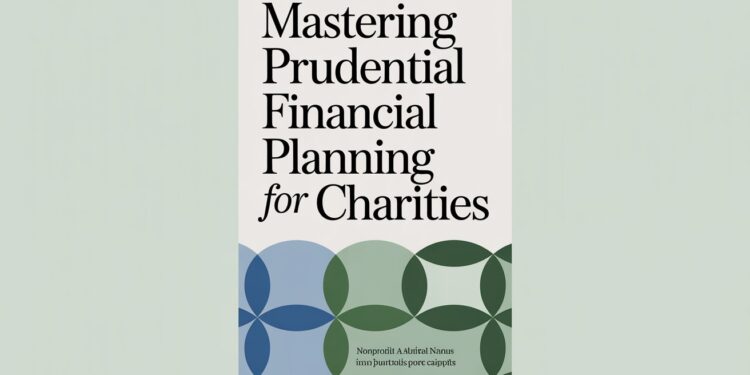In today’s fast-changing financial climate, charities face more complexity than ever before. Economic volatility, donor fatigue, and compliance pressures make it essential for nonprofit organizations to embrace prudential financial planning for charities. This approach goes beyond routine budgeting—it builds a disciplined framework for stewardship, sustainability, and resilience. Prudential financial planning ensures that a charity can fulfill its mission not only today but for generations to come.
Understanding Prudential Financial Planning for Charities
At its core, prudential financial planning for charities means managing financial resources with foresight, caution, and accountability. “Prudential” refers to the practice of acting wisely to balance risk and opportunity. In the charitable sector, this involves establishing policies, controls, and reserves that protect the organization from unexpected downturns or funding gaps.
Unlike ordinary planning, prudential financial management emphasizes long-term stability. It integrates liquidity management, ethical investment policies, and transparent reporting to ensure that every decision supports both short-term operations and long-term mission objectives. A well-designed prudential framework protects a charity’s reputation, enhances donor confidence, and ensures compliance with regulatory standards.
The Importance of Financial Governance
Good governance is the backbone of prudential financial planning. Charity trustees and board members hold fiduciary duties of care, loyalty, and compliance. Their oversight ensures that resources are used responsibly and transparently.
A robust governance structure should include:
- Financial and investment policies that define acceptable risk levels and asset allocation.
- Conflict-of-interest protocols to prevent misuse of funds.
- Regular financial audits to maintain transparency and donor trust.
Governance also requires ongoing education. Trustees must understand financial statements, risk indicators, and the implications of restricted versus unrestricted funds. The more financially literate the leadership, the more effectively they can safeguard the charity’s future.
Building a Strong Financial Foundation
Every successful nonprofit starts with a stable financial foundation. This begins by setting clear, measurable financial objectives aligned with mission goals. A multi-year financial plan should include revenue projections, expense estimates, and cash flow targets.
To achieve this, charities should:
- Develop multi-year budgets that include optimistic, realistic, and conservative forecasts.
- Identify cost drivers and align spending with strategic priorities.
- Plan for capital and operational needs, ensuring that fixed assets and infrastructure are sustainably funded.
A prudential charity never relies on hope alone—it models multiple outcomes to stay prepared for funding shortfalls or economic downturns.
Budgeting for Nonprofits the Smart Way
Budgeting is not just about balancing numbers—it’s about aligning financial resources with purpose. Effective prudential financial planning for charities uses budgets as strategic tools.
Key steps include:
- Separating restricted and unrestricted funds, ensuring compliance with donor intent.
- Allocating a portion of income to build reserves for emergencies.
- Performing rolling forecasts to adjust budgets as conditions change.
Scenario planning is also vital. A charity should be ready for “what if” events such as a 15% drop in donations, delays in grant payments, or unexpected cost increases. A prudential budget doesn’t eliminate uncertainty—it manages it proactively.
Cash Flow and Liquidity Management
A charity’s financial health depends on liquidity—the ability to meet obligations when they fall due. Even profitable organizations can fail if cash dries up.
A 13-week rolling cash-flow forecast is one of the best prudential tools available. It tracks inflows and outflows, highlights potential shortfalls, and helps management make timely decisions. Charities should aim to maintain 90–180 days of operating cash as a safety buffer.
Practical liquidity tactics include:
- Keeping funds in three tiers: immediate operating cash, short-term deposits, and longer-term reserves.
- Using transparent treasury management procedures.
- Reviewing cash flow weekly during volatile periods.
Prudential cash planning ensures that mission-critical programs continue uninterrupted even in lean times.
Strategic Reserve and Investment Planning
Reserves are the financial backbone of sustainability. A reserves policy defines how much money should be set aside and under what conditions it may be used. Prudential planning encourages charities to maintain reserves equivalent to at least three to six months of fixed costs.
Investment planning complements reserves by making idle funds work productively. An Investment Policy Statement (IPS) outlines time horizons, acceptable risk, and ethical considerations. Many charities now integrate socially responsible or faith-based screens to align investments with their mission.
Reserves and investments serve dual purposes: protecting against risk and enabling opportunity. When managed prudently, they create financial independence and strategic agility.
Risk Management and Compliance
Charities operate in a complex environment—regulations, reputational threats, and operational risks can undermine even the best-run organizations. Prudential financial planning for charities demands a structured risk management framework.
Start by building a risk register that identifies key threats such as funding concentration, fraud, compliance failures, or data breaches. Each risk should have an owner, probability, impact rating, and mitigation plan.
Insurance is another vital layer of protection. Essential covers include:
- Trustee and officer liability insurance.
- Professional indemnity insurance.
- Cybersecurity and data-breach protection.
Compliance should never be reactive. Regular policy reviews, staff training, and internal audits keep organizations both ethical and compliant.
Revenue Diversification and Sustainability
Relying on a single donor or funding source exposes a charity to financial stress. Prudential planning encourages diversified revenue streams—combining grants, corporate partnerships, fundraising campaigns, and earned income.
Diversification not only stabilizes income but also allows flexibility in programming. Effective strategies include:
- Building relationships with multiple grant makers.
- Developing recurring donation programs.
- Exploring mission-aligned social enterprises.
Charities should monitor the cost-to-raise-a-dollar ratio to ensure fundraising remains efficient. The goal is long-term sustainability, not short-term cash spikes.
Internal Controls and Accountability
Strong internal controls prevent fraud, error, and misuse of charitable funds. Every charity—large or small—needs segregation of duties, dual payment approvals, and regular reconciliations.
A prudential control environment includes:
- Documented approval processes for spending and procurement.
- Restricted user access in financial software.
- Monthly variance analysis comparing actual results with the budget.
Accountability extends to transparent reporting. Regular board finance packs, external audits, and open financial statements reinforce donor trust and organizational credibility.
Technology and Financial Transparency
Digital transformation is reshaping the nonprofit sector. Cloud-based accounting, donor relationship management (CRM) systems, and data visualization dashboards provide real-time insights and transparency.
Implementing technology supports prudential financial planning by:
- Automating repetitive tasks like expense tracking and bank reconciliation.
- Reducing human error and enhancing audit readiness.
- Demonstrating openness through online annual reports and dashboards.
Charities that leverage technology efficiently strengthen both internal decision-making and external accountability.
Measuring Financial Health and Performance
Performance measurement converts financial data into strategic intelligence. Common prudential indicators include:
- Days cash on hand – measures liquidity and resilience.
- Reserves ratio – evaluates financial cushion.
- Unrestricted net assets – shows financial flexibility.
- Fundraising ROI – assesses revenue efficiency.
Benchmarking against peers and historical trends helps identify weaknesses early. Continuous improvement, based on evidence, is a hallmark of prudential financial leadership.
Training and Capacity Building
No financial strategy can succeed without capable people. Training equips staff and trustees with the skills to interpret data, manage budgets, and comply with regulations.
Charities should prioritize:
- Regular finance workshops for program managers.
- Trustee induction programs focusing on fiduciary responsibilities.
- Cross-training to ensure continuity during absences.
Outsourcing specialized tasks—like audits or investment management—can also strengthen overall capacity while maintaining prudence.
Case Studies and Best Practices
Around the world, charities that embrace prudential financial planning have weathered economic shocks better than those without structured plans. For example:
- A community foundation with a robust reserves policy maintained programs during a funding freeze.
- A small health nonprofit reduced financial stress by adopting rolling cash-flow forecasts and cloud-based accounting.
- A faith-based organization implemented Shariah-compliant investments to align finance with its values while maintaining steady returns.
These examples show that prudence is not about limiting ambition—it’s about securing impact through discipline.
Frequently Asked Questions (FAQs)
What is prudential financial planning for charities?
It’s a strategic approach that combines cautious budgeting, disciplined reserves, and transparent governance to ensure long-term financial sustainability.
How much reserve should a charity hold?
Most experts recommend maintaining between three to six months of operating expenses, depending on cash flow volatility and risk exposure.
How does prudential planning improve donor trust?
By ensuring transparent reporting, clear policies, and consistent financial health, donors gain confidence that funds are used effectively and ethically.
Can small charities implement prudential financial planning?
Absolutely. Even simple practices—like a cash-flow forecast, two-signature payments, and a basic reserves policy—build significant financial resilience.
Conclusion
Prudential financial planning for charities is more than an accounting exercise—it’s a philosophy of stewardship. By combining disciplined budgeting, risk management, ethical investment, and transparent reporting, nonprofits can secure both financial health and mission success.
A sustainable charity is one that plans ahead, acts responsibly, and builds resilience against uncertainty. Implementing a prudential framework transforms financial management from reactive crisis handling into proactive sustainability planning. The result is simple yet powerful: greater donor confidence, stronger governance, and a lasting ability to create social good.
Do Read: Best Practices for Safe and Efficient Pipeline Cleaning



















